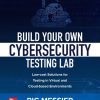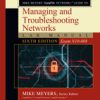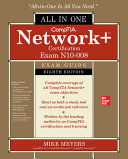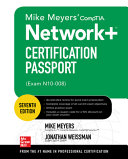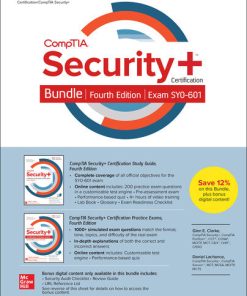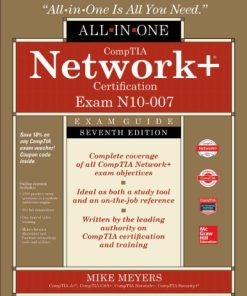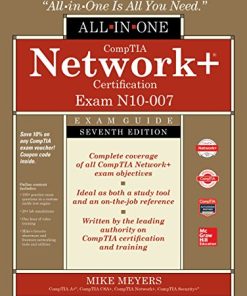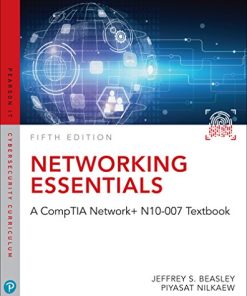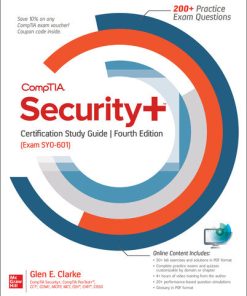CompTIA Network Certification Study Guide 17th edition by Glen E. Clarke 1260122050 9781260122053
$50.00 Original price was: $50.00.$25.00Current price is: $25.00.
CompTIA Network+ Certification Study Guide 17th edition by Glen E. Clarke – Ebook PDF Instant Download/DeliveryISBN: 1260122050 9781260122053
Full download CompTIA Network+ Certification Study Guide 17th edition by Glen E. Clarke edition after payment.
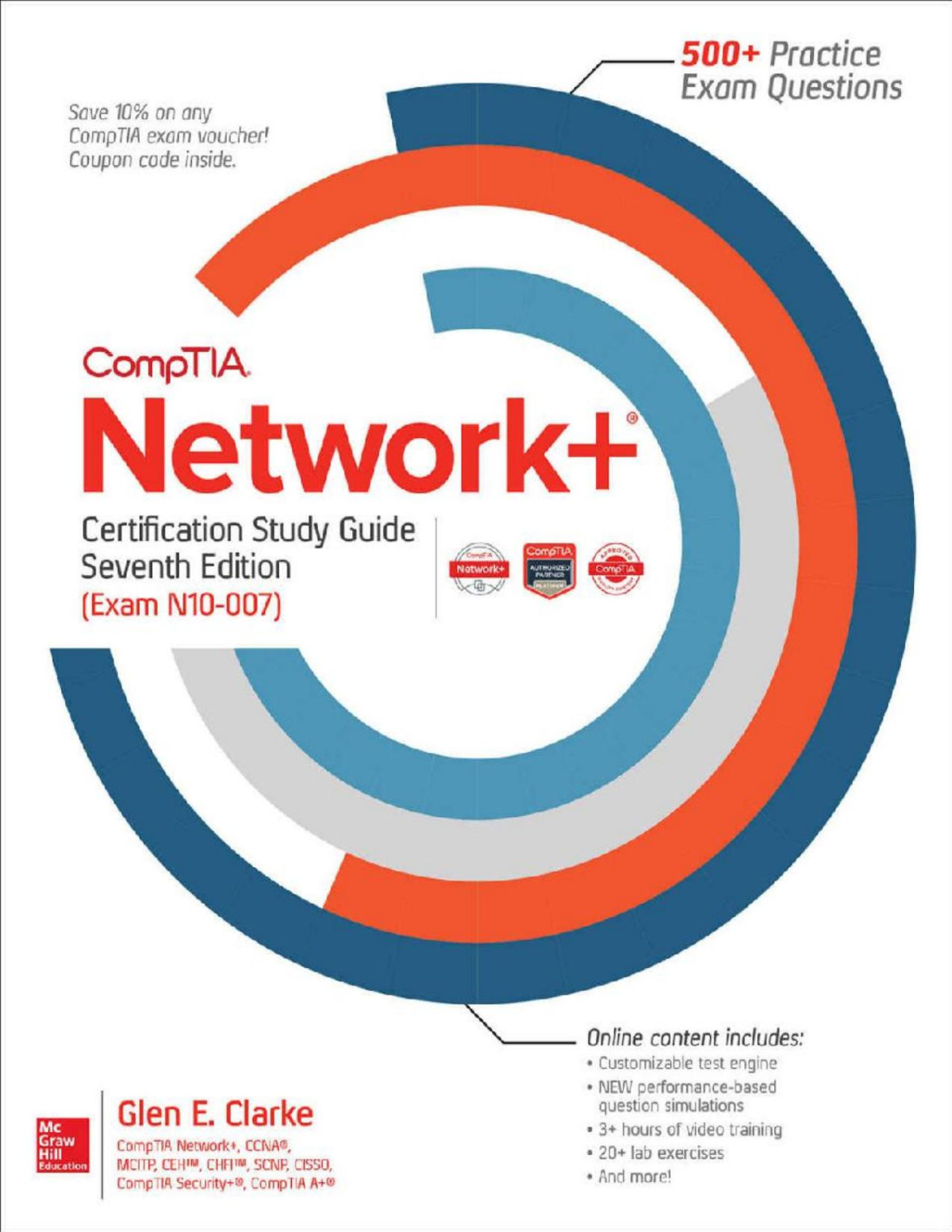
Product details:
ISBN-10 : 1260122050
ISBN-13 : 9781260122053
Author : Glen E. Clarke
Your complete exam prep course with digital content—500+ practice exam questions, 3+ hours of video training, and much more With hundreds of practice exam questions, including new performance-based types, CompTIA Network+® Certification Study Guide, Seventh Edition (Exam N10-007) covers everything you need to know to prepare for this challenging exam. •100% complete coverage of all official objectives for exam N10-007 •Exam Watch notes call attention to information about, and potential pitfalls in, the exam •Exam Readiness checklist—you’re ready for the exam when all objectives on the list are checked off •Inside the Exam sections highlight key exam topics covered •Two-Minute Drills for quick review at the end of every chapter •Simulated exam questions match the format, tone, topics, and difficulty of the real exam Covers all the exam topics, including: Basic Network Concepts • Network Protocols and Standards • Networking Components • TCP/IP Addressing • TCP/IP Protocols • TCP/IP Utilities and Troubleshooting • Configuring Routers and Switches • Subnetting and Routing • Configuring Network Services • Wireless Networking • Remote Access and VPN Connectivity • Wide Area Network Technologies • Maintaining and Supporting a Network • Network Security Principles • Network Security Practices • Monitoring the Network • Troubleshooting the Network Online content includes: •500+ practice exam questions •Test engine that provides full-length practice exams or customized quizzes based on chapters or exam objectives •NEW performance-based question simulations •Pre-assessment test •3+ hours of video training •20+ lab exercises and solutions •Bonus chapter! “Implementing a Network” •Quick Review Guide •Glossary
CompTIA Network+ Certification Study Guide 17th Table of contents:
1 Basic Network Concepts
Identifying Characteristics of a Network
Servers, Workstations, and Hosts
LANs, WANs, and MANs
Types of Networks
Internet, Intranet, and Extranet
Identifying Network Topologies
Bus Topologies
Star Topologies
Mesh Topologies
Ring Topologies
Hybrid Topologies
Wireless Topologies
Point-to-Point and Point-to-Multipoint
Logical vs. Physical
Segments and Backbones
Network Media and Connectors
Coaxial Cable
Twisted-Pair Cable
Exercise 1-1: Crimping a Category 5 Cable
Fiber-Optic Cable
Connector Types
Networking over Power Lines
Media Converters
Access Methods
CSMA/CD
CSMA/CA
Modulation Techniques
Network Architectures
Baseband and Broadband
Fast Ethernet (100BaseT and 100BaseFX)
Gigabit Ethernet
10-Gigabit Ethernet
Exercise 1-2: Identifying the Different Network Architectures
Network Operating Systems
Windows Servers
Exercise 1-3: Installing DNS on a Windows Server
UNIX/Linux
Certification Summary
Two-Minute Drill
Q&A Self Test
Self Test Answers
2 Network Protocols and Standards
Network Protocols
NetBEUI
What Is NetBIOS?
TCP/IP
Routable vs. Nonroutable Protocols
The OSI Model
Layer 7: The Application Layer
Layer 6: The Presentation Layer
Layer 5: The Session Layer
Layer 4: The Transport Layer
Layer 3: The Network Layer
Layer 2: The Data Link Layer
Layer 1: The Physical Layer
Data Encapsulation
Exercise 2-1: Mixing and Matching OSI Model Definitions
Protocols and the OSI Layers
Exercise 2-2: Viewing Protocol Information with Network Monitor
Exercise 2-3: Analyzing Network Traffic
802 Project Standards
IEEE 802 Categories
Certification Summary
Two-Minute Drill
Q&A Self Test
Self Test Answers
3 Networking Components
Network Interface Cards
Transceivers
Exercise 3-1: Configuring a Network Card
MAC Address
Exercise 3-2: Determining Your Local Machine’s MAC Address
Troubleshooting Network Cards
Hubs and Repeaters
Hubs
Repeaters
Bridges and Switches
Bridges
Switches
Routers and Multilayer Switches
Routers
Multilayer Switches
Collision Domains and Broadcast Domains
Gateways, Security Devices, Virtualization, and Cloud Computing
Gateways
Firewalls
Intrusion Detection Systems
Exercise 3-3: Identifying Network Components
Other Networking Devices
Wireless Access Points
Wireless Range Extender
VoIP End Point
Analog Modems
CSU/DSU
ISDN
Advanced Networking Devices
Virtualization
Cloud Computing
Network Storage Types
SCADA/ICS and Medianets
Wiring Distribution and Rack Systems
Device Placement and Labeling
Certification Summary
Two-Minute Drill
Q&A Self Test
Self Test Answers
4 TCP/IP Addressing
TCP/IP Fundamentals
TCP/IP Settings
Exercise 4-1: Identifying Remote Systems
TCP/IP Addressing
Understanding Binary
Exercise 4-2: Converting Decimal to Binary
Exercise 4-3: Converting Binary to Decimal
Address Classes
Exercise 4-4: Identifying Address Classes
Loopback Address
Private vs. Public Addresses
Exercise 4-5: Understanding Valid Addresses
Virtual IP
Addressing Schemes
TCP/IP Ports
Exercise 4-6: Viewing TCP/IP Port Values
TCP/IP Configuration Concepts
Manual Configuration/Static Address
Dynamic Host Configuration Protocol (DHCP)
Exercise 4-7: Configuring TCP/IP to Use DHCP
APIPA
Boot Protocol
IP Reservations
Domain Name System
Windows Internet Naming Service
Exercise 4-8: Configuring a Client for DNS
Configuring a Linux Machine for TCP/IP
Certification Summary
Two-Minute Drill
Q&A Self Test
Self Test Answers
5 TCP/IP Protocols
TCP/IP Protocol Suite
The TCP/IP Model
Exercise 5-1: Identifying TCP/IP Protocols
IPv6 Fundamentals
IPv6 Addressing and Hexadecimal Addressing
IPv6 Protocols
Tunneling Protocols
Exercise 5-2: Exploring IPv6
Network Services
Web Services
Network Controllers
DHCP
DNS
RDP
WINS
NAT/PAT/SNAT
ICS
SMB/CIFS
NFS
AFP
Samba
ZeroConfig
VoIP
Unified Voice Services
IPAM
Certification Summary
Two-Minute Drill
Q&A Self Test
Self Test Answers
6 TCP/IP Utilities and Troubleshooting
Communication Requires ARP
ARP Cache
Exercise 6-1: Using ARP to See Your Local ARP Cache
RARP
Common TCP/IP Commands
IPCONFIG and ifconfig
Exercise 6-2: Using IPCONFIG
Ping and Hping2
Exercise 6-3: Using Ping
Tracert/traceroute
Netstat
Exercise 6-4: Using Netstat to Determine Open Connections to a System
Telnet
Exercise 6-5: Using Telnet to Remotely Administer a Cisco Router
FTP
Exercise 6-6: Configuring and Using FTP
Name Resolution Commands
DNS Resolver Cache
Exercise 6-7: Windows DNS Resolver Cache
NSLOOKUP and DIG
Exercise 6-8: Using NSLOOKUP
TCP/IP Utilities
Hostname and Host
MTR
Route
Arping
Pathping
MAC Address Lookup Table
Troubleshooting with TCP/IP Utilities
Connectivity Problems
Name-Resolution Problems
Software Tools
Exercise 6-9: Performing a Port Scan
Certification Summary
Two-Minute Drill
Q&A Self Test
Self Test Answers
7 Configuring Routers and Switches
Basic Router Configuration
Configuration Modes
Configuring the Hostname
Configuring Interfaces
Exercise 7-1: Performing Basic Configuration of Cisco Routers
Segmenting into Zones
Basic Switch Configuration
Configuring Interfaces
Configuring VLANs
Port Mirroring
Exercise 7-2: Configuring VLANs on Cisco Switches
Configuring Port Security
Switch Management
Troubleshooting Connectivity
Layer-1 and Layer-2 Troubleshooting
Layer-3 Troubleshooting
Certification Summary
Two-Minute Drill
Q&A Self Test
Self Test Answers
8 Subnetting and Routing
Understanding Subnetting
Exercise 8-1: Subnetting IP Addresses
Classful vs. Classless Addressing
CIDR
Exercise 8-2: Subnetting Networks
VLSM in Detail
Understanding Routing and Static Routes
Routing Concepts
Cisco Routers
Exercise 8-3: Configuring Cisco Routers
Windows Routers
Dynamic Routing Protocols
Routing Metrics
Distance Vector
Link State
Hybrid
Advanced Concepts
Certification Summary
Two-Minute Drill
Q&A Self Test
Self Test Answers
9 Configuring Network Services
Understanding DNS
DNS Overview
Configuring DNS Records
Dynamic DNS
Exercise 9-1: Installing and Configuring DNS
Deploying DHCP
DHCP Overview
Configuring DHCP
Configuring Reservations
Exercise 9-2: Installing and Configuring DHCP
DHCP Relay and IP Helper
Implementing NAT
NAT Overview
Configuring NAT
Exercise 9-3: Configuring NAT on Windows Server
Other Network Services
Port Forwarding
Exercise 9-4: Configuring Port Forwarding
Proxy Servers
Unified Communications
Access Control List
Distributed Switching
Software-Defined Networking
Certification Summary
Two-Minute Drill
Q&A Self Test
Self Test Answers
10 Wireless Networking
Wireless Basics
Wireless Concepts
Wireless Network Types
Wireless Standards
Channels
Authentication and Encryption
Securing Wireless
Security Best Practices
Threats Against Wireless
Implementing a Wireless Network
Configuring the Wireless Router/Access Point
Wireless Security
Configuring the Client
Exercise 10-1: Configuring a Wireless Network
Configuring Roaming Wireless
Understanding Mobile Devices
Troubleshooting Wireless
Other Wireless Networking
Infrared (IR)
Bluetooth
NFC
Cellular
Technologies that Facilitate the Internet of Things (IoT)
Geofencing
Certification Summary
Two-Minute Drill
Q&A Self Test
Self Test Answers
11 Remote Access and VPN Connectivity
Remote Connectivity Concepts
Remote Access and Administration
Out-of-Band Management
Public Switched Telephone Network
Integrated Services Digital Network
Remote Access Service (RAS)
Serial Line Internet Protocol
Point-to-Point Protocol
Exercise 11-1: Enabling Modem Logging in Windows
Dial-Up Networking
Purpose of Modems
Requirements for a Remote Connection
Exercise 11-2: Creating a PPP Dial-Up Connection
Virtual Private Networks (VPNs)
VPN Overview
VPN Protocols
Exercise 11-3: Setting Up a VPN Server
Exercise 11-4: Setting Up a VPN Client
Certification Summary
Two-Minute Drill
Q&A Self Test
Self Test Answers
12 Wide Area Network Technologies
Packet-Switching vs. Circuit-Switching Networks
Packet Switching
Circuit Switching
X.25 and Frame Relay
Fiber-Optic WAN Technologies
Synchronous Optical Network/Synchronous Digital Hierarchy
Optical Carrier Level-X
Fiber Distributed Data Interface
Asynchronous Transfer Mode
Internet Access Technologies
Leased Lines with Tx-/Ex-Carriers
DSL/ADSL
Broadband Cable
High Speed via Satellite and Cellular Networks
Other Methods of Internet Access
Certification Summary
Two-Minute Drill
Q&A Self Test
Self Test Answers
13 Maintaining and Supporting a Network
Network Upgrades and Downgrades
Safety Practices
Software Upgrades
Hardware Upgrades
Installing Patches and Updates
Exercise 13-1: Configuring Windows Update
Windows Server Update Services (WSUS)
Antivirus and Antispyware Software
Antivirus Software
Antispyware/Adware
Backing Up Network Data
Tape Drives
Archives
Full, Incremental, and Differential Backups
Scheduling Backups
Exercise 13-2: Backing Up and Restoring Data on a Windows Server
Providing Fault Tolerance
RAID Level 0
RAID Level 1
RAID Level 5
Exercise 13-3: Understanding and Configuring Fault Tolerance
Network Documentation and Configuration Management
Diagram Symbols
Wiring Schematics
Physical Network Diagrams
Logical Network Diagrams
Inventory Management and Labeling
IP Address Utilization
Vendor Documentation
Baselines
Internal Policies, Procedures, and Standards
Change Management Documentation
Configuration Management
Certification Summary
Two-Minute Drill
Q&A Self Test
Self Test Answers
14 Network Security Principles
Understanding Attack Types
Social Engineering
Phishing Attack
Network-Based Attacks
Common Vulnerabilities
Malicious Software
Mitigating Attacks
Understanding System Security
Authentication
Authorization
Windows Security Subsystem
Configuring Permissions
Securing the Registry
Exercise 14-1: Setting Permissions on Registry Keys
Configuring User Rights
Exercise 14-2: Modifying User Rights on a Windows System
Configuring Auditing
Exercise 14-3: Implementing Auditing in Windows
Implementing Network Security
Network Access Security
Securing Communication
Defining Data Encryption
Encryption Methods
Encryption Standards
Methods of Securing Traffic
Availability Concepts and Disaster Recovery
Fault Tolerance
High Availability
Power Management
Disaster Recovery and Business Continuity
Guidelines to Protect the Network
Physical Security
Firewalls
Intrusion Detection Systems
Patch Management
Hardening Devices and Systems
Data Encryption
Policies and Procedures
Vulnerability Testing and Penetration Testing
End-User Awareness and Training
Certification Summary
Two-Minute Drill
Q&A Self Test
Self Test Answers
15 Network Security Practices
Physical Security Controls
Securing the Premises
Detective Controls
Prevention Controls
Network Closet/Server Room
Access Control Methods
Implementing Network Device Hardening Techniques
Account Best Practices
Patching and Updates
Cryptography Technologies
Security Policy and Access Control Models
Antimalware Software
Disable Unused Ports
Switch Port Security
Disabling Unnecessary Services
Network Segmentation and Access Lists
Use Secure Protocols
Implementing Firewalls
Firewall Architecture
Firewall Types
Other Firewall Features
Configuring Access Control Lists
Exercise 15-1: Enabling the Windows Firewall
Common Mitigation Techniques
Signature Management
Device Hardening
Switch Port Protection
Network Segmentation
Other Mitigation Techniques
Certification Summary
Two-Minute Drill
Q&A Self Test
Self Test Answers
16 Monitoring the Network
Monitoring and Logging
Monitoring
Logging
Monitoring Processes and Tools
Log Reviewing
Packet/Traffic Analysis
Port Scanning
Exercise 16-1: Using a Port Scanner
Vulnerability Scanning
Patch Management and Rollback
Reviewing Baselines with System Monitor
Exercise 16-2: Using System Monitor
Event Viewer
Exercise 16-3: Checking Event Logs
Other Monitoring Tools
Event Management
Environmental and Power Monitoring
Monitoring Techniques to Track Problems
Monitoring Best Practices
Monitoring Utilization
Interface Monitoring and Metrics
Certification Summary
Two-Minute Drill
Q&A Self Test
Self Test Answers
17 Troubleshooting the Network
Managing Network Problems
Does the Problem Exist Across the Network?
Workstation, Workgroup, LAN, or WAN Problem?
Is the Problem Consistent and Replicable?
Standard Troubleshooting Methods
Network Troubleshooting Methodology
Step 1: Identify the Problem
Step 2: Establish a Theory of Probable Cause
Step 3: Test the Theory to Determine Cause
Step 4: Establish a Plan of Action to Resolve the Problem and Identify Potential Effects
Step 5: Implement the Solution or Escalate as Necessary
Step 6: Verify Full System Functionality and, if Applicable, Implement Preventative Measures
Step 7: Document Findings, Actions, and Outcomes
Sample Troubleshooting Situations
Common Network Issues and Their Indicators
Checking Physical and Logical Indicators
Link Lights
Collision Lights and Switch Status Lights
Power Lights
Error Displays
Error Logs and Displays
Performance Issues and Optimization
Troubleshoot Common Wired Connectivity and Performance Issues
Other Symptoms and Causes of Network Problems
Recognizing Abnormal Physical Conditions
Isolating and Correcting Problems in the Physical Media
Checking the Status of Servers
Troubleshoot Common Network Service Issues
Common Network Troubleshooting Issues
Checking for Viruses
Checking the Validity of the Account Name and Password
Rechecking Operator Logon Procedures
Selecting and Running Appropriate Diagnostics
Network Troubleshooting Tools
Cable Crimper, Wire Stripper, and Punch-Down Tool
Cable Tester, Certifier, and Butt Set
Crossover Cables
Loopback Adapter, Line Testers, and Light Meter
Tone Generator/Toner Probe
TDR and OTDR
Oscilloscopes
Multimeter
Spectrum Analyzer
Software Troubleshooting Tools
Certification Summary
Two-Minute Drill
Q&A Self Test
Self Test Answers
Appendix About the Online Content
People also search for CompTIA Network+ Certification Study Guide 17th:
comptia network+ n10 009 certification study guide
comptia security+ certification study guide network security essentials
comptia network+ n10 008 certification study guide pdf free
comptia a+ certification study guide pdf
a certification study guide pdf
Tags:
CompTIA Network,Certification Study Guide,digital content
You may also like…
Computers - Computer Certification & Training
CompTIA Network+ Certification All-in-One Exam Guide (Exam N10-008) 8th Edition Mike Meyers
Computers - Computer Certification & Training
CompTIA Security+ Certification Bundle (Exam SY0-601) 4th Edition
Computers - Networking
CompTIA Network+ N10-008 Exam Cram 7th Edition Emmett Dulaney
Computers - Networking
CompTIA Network+ Certification All-in-One Exam Guide, Seventh Edition (Exam N10-007)
Computers - Computer Certification & Training
Uncategorized
Computers & Technology


